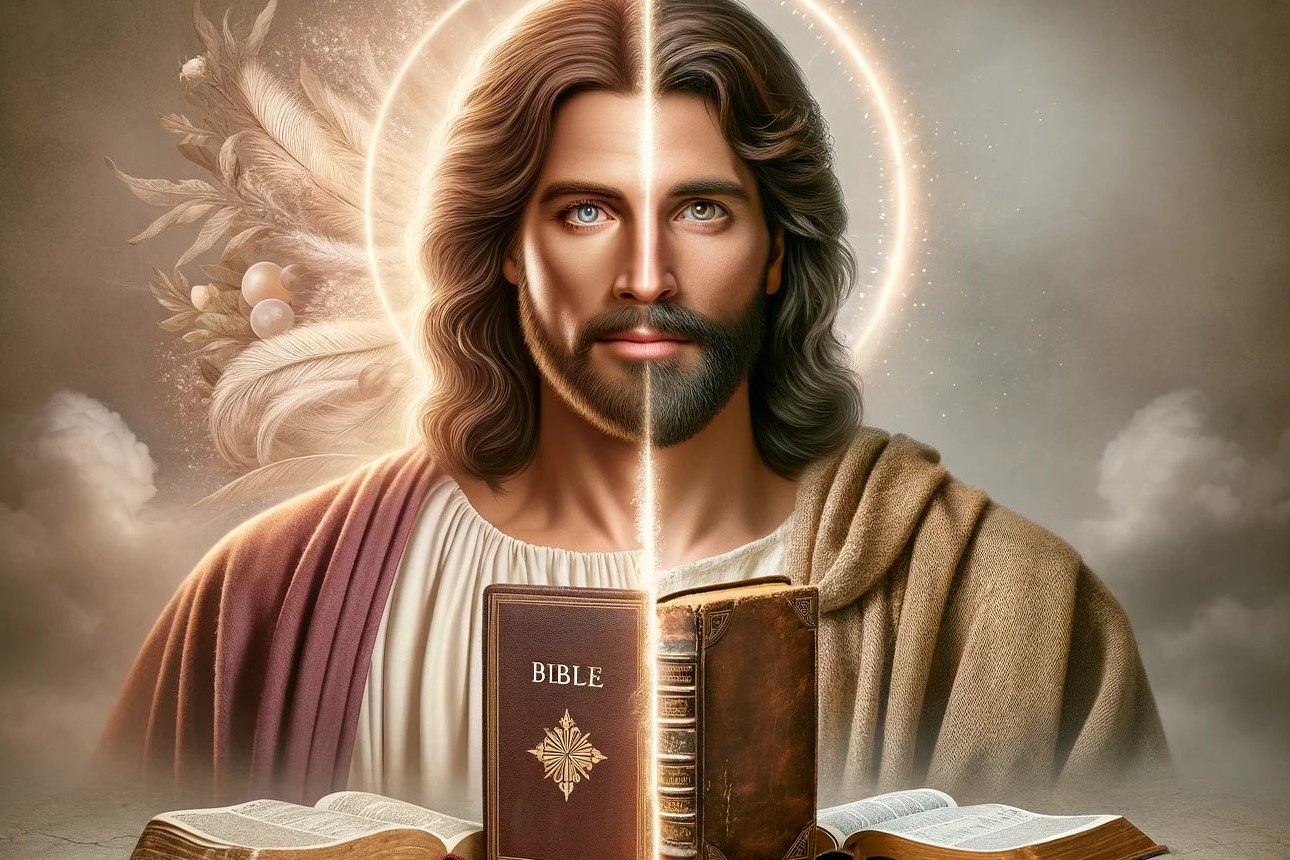Home>Christian Videos>Bible Stories>How Does The Bible Describe Jesus Christ?


Bible Stories
How Does The Bible Describe Jesus Christ?
Published: February 29, 2024
Ericka Andersen, an editor at Christian.net, expertly merges digital strategy with content creation, focusing on faith and societal issues. Her communication skills enhance the platform's engaging narratives, fostering meaningful dialogue on belief's impact on society.
Discover how the Bible portrays Jesus Christ through captivating and insightful stories. Explore the biblical narratives and gain a deeper understanding of his character and teachings. Unlock the timeless wisdom of the Bible-stories.
(Many of the links in this article redirect to a specific reviewed product. Your purchase of these products through affiliate links helps to generate commission for Christian.net, at no extra cost. Learn more)
Table of Contents
Introduction
The Bible is a sacred text that holds great significance for millions of people around the world. Within its pages, Jesus Christ is described in various ways, each shedding light on different aspects of his identity and purpose. From being the Son of God to the Prince of Peace, the Bible offers a multifaceted portrayal of Jesus Christ that has shaped the beliefs and practices of countless individuals and communities throughout history. In this article, we will explore how the Bible describes Jesus Christ, delving into the rich tapestry of biblical references that contribute to the understanding of his divine nature and role in the world.
The Son of God
The title "Son of God" is one of the most significant and profound descriptions of Jesus Christ in the Bible. It signifies his divine nature and his unique relationship with God the Father. In the New Testament, particularly in the Gospels of Matthew, Mark, Luke, and John, Jesus is referred to as the Son of God numerous times. This designation emphasizes his role as the embodiment of God's love and grace, sent to earth to fulfill the divine plan of salvation for humanity. The concept of Jesus as the Son of God is central to Christian theology and forms the foundation of the belief in the Holy Trinity, where God is understood as existing in three persons: the Father, the Son, and the Holy Spirit. This portrayal of Jesus as the Son of God underscores his authority, holiness, and eternal nature, making it a cornerstone of Christian faith and devotion.
- Jesus as the Son of God signifies his divine nature and unique relationship with God the Father.
- This title is prominently featured in the New Testament, particularly in the Gospels.
- It emphasizes Jesus' role in fulfilling the divine plan of salvation for humanity.
- The concept of Jesus as the Son of God forms the basis of the belief in the Holy Trinity.
- This portrayal underscores Jesus' authority, holiness, and eternal nature, shaping Christian faith and devotion.
The Savior of the World
The Bible describes Jesus Christ as the Savior of the World, emphasizing his role in providing salvation and redemption for all humanity. This portrayal is particularly evident in the New Testament, where Jesus' sacrificial death and resurrection are depicted as the means through which individuals can be reconciled with God and attain eternal life. The Gospel of John, for instance, highlights Jesus' mission to offer salvation to the world, stating, "For God so loved the world that he gave his one and only Son, that whoever believes in him shall not perish but have eternal life." This verse encapsulates the essence of Jesus' identity as the Savior, emphasizing the universal scope of his redemptive work and the offer of eternal life to those who place their faith in him. The concept of Jesus as the Savior of the World is central to Christian belief, serving as a source of hope, comfort, and assurance for believers as they navigate the challenges of life and anticipate the promise of everlasting salvation.
- Jesus is depicted as the Savior of the World in the New Testament, emphasizing his role in providing salvation and redemption for all humanity.
- The Gospel of John highlights Jesus' mission to offer salvation to the world, emphasizing the universal scope of his redemptive work and the offer of eternal life to those who believe in him.
- The concept of Jesus as the Savior of the World is central to Christian belief, offering hope, comfort, and assurance to believers.
The Good Shepherd
In the Bible, Jesus Christ is described as the Good Shepherd, a metaphor that conveys his loving care, guidance, and protection for his followers. This imagery is found in the Gospel of John, where Jesus declares, "I am the good shepherd. The good shepherd lays down his life for the sheep." This portrayal emphasizes Jesus' deep compassion and sacrificial nature, illustrating his willingness to sacrifice himself for the well-being of those under his care. The Good Shepherd metaphor also highlights the intimate relationship between Jesus and his followers, portraying him as the one who knows his sheep by name and leads them to safety and nourishment. This depiction of Jesus as the Good Shepherd has been a source of comfort and reassurance for Christians throughout history, reminding them of Jesus' unwavering commitment to guide and protect them amidst life's challenges and uncertainties.
- The Good Shepherd metaphor conveys Jesus' loving care, guidance, and protection for his followers.
- Found in the Gospel of John, it emphasizes Jesus' deep compassion and sacrificial nature.
- Illustrates Jesus' willingness to sacrifice himself for the well-being of those under his care.
- Highlights the intimate relationship between Jesus and his followers, portraying him as the one who knows his sheep by name and leads them to safety and nourishment.
- A source of comfort and reassurance for Christians, reminding them of Jesus' unwavering commitment to guide and protect them.
The Light of the World
In the Bible, Jesus Christ is described as the Light of the World, a powerful metaphor that illuminates his role in dispelling darkness, ignorance, and spiritual blindness. This profound imagery is found in the Gospel of John, where Jesus declares, "I am the light of the world. Whoever follows me will never walk in darkness but will have the light of life." This portrayal emphasizes Jesus' capacity to bring clarity, truth, and spiritual enlightenment to those who embrace him. The concept of Jesus as the Light of the World signifies his transformative influence, guiding individuals out of the shadows of sin and into the radiance of divine grace and salvation. This metaphor also underscores the contrast between light and darkness, portraying Jesus as the embodiment of purity and righteousness in a world fraught with moral and spiritual obscurity. The imagery of Jesus as the Light of the World has resonated deeply with believers, inspiring them to seek spiritual illumination and find solace in the radiance of Christ's eternal light.
- Jesus is described as the Light of the World in the Gospel of John, symbolizing his role in dispelling darkness, ignorance, and spiritual blindness.
- This portrayal emphasizes Jesus' capacity to bring clarity, truth, and spiritual enlightenment to those who embrace him.
- Signifies his transformative influence, guiding individuals out of the shadows of sin and into the radiance of divine grace and salvation.
- Portrays Jesus as the embodiment of purity and righteousness in a world fraught with moral and spiritual obscurity.
- The imagery of Jesus as the Light of the World has inspired believers to seek spiritual illumination and find solace in the radiance of Christ's eternal light.
Read more: How Does Paul Describe Baptism
The Prince of Peace
In the Bible, Jesus Christ is described as the Prince of Peace, a title that encapsulates his role in bringing reconciliation, harmony, and tranquility to humanity. This profound designation is found in the book of Isaiah in the Old Testament, where the prophet foretells the coming of a divine figure who will be known as the Prince of Peace. The significance of this portrayal is further emphasized in the New Testament, particularly in the Gospel of Luke, where the birth of Jesus is heralded with the proclamation of peace on earth and goodwill toward humanity. The title "Prince of Peace" underscores Jesus' mission to establish a kingdom characterized by peace, justice, and the restoration of broken relationships, both between individuals and between humanity and God.
This portrayal of Jesus as the Prince of Peace holds profound significance for believers, offering a message of hope and reconciliation in a world marked by conflict and division. It speaks to the deep longing for inner tranquility and global harmony, pointing to Jesus as the ultimate source of peace for the human heart and the world at large. The Prince of Peace metaphor also highlights Jesus' authority and sovereignty in ushering in a reign of peace that transcends earthly circumstances and extends into the eternal realm. As the Prince of Peace, Jesus embodies the divine promise of a future characterized by wholeness, unity, and the absence of strife, serving as an enduring source of comfort and inspiration for those who seek solace in his transformative message of peace.
- Jesus is described as the Prince of Peace, bringing reconciliation, harmony, and tranquility to humanity.
- The title is found in the book of Isaiah in the Old Testament and is emphasized in the New Testament, particularly in the Gospel of Luke.
- It underscores Jesus' mission to establish a kingdom characterized by peace, justice, and the restoration of broken relationships.
- The portrayal offers a message of hope and reconciliation in a world marked by conflict and division, pointing to Jesus as the ultimate source of peace for the human heart and the world at large.
- It highlights Jesus' authority and sovereignty in ushering in a reign of peace that extends into the eternal realm.
- As the Prince of Peace, Jesus embodies the divine promise of a future characterized by wholeness, unity, and the absence of strife, serving as an enduring source of comfort and inspiration.
The Lamb of God
In the Bible, Jesus Christ is described as the Lamb of God, a profound and symbolic representation of his sacrificial role in atoning for the sins of humanity. This imagery is particularly prominent in the New Testament, where Jesus is depicted as the ultimate sacrificial lamb whose death serves as the means of redemption for all who believe in him. The Gospel of John portrays Jesus as the Lamb of God, with John the Baptist proclaiming, "Behold, the Lamb of God, who takes away the sin of the world!" This designation harkens back to the Old Testament sacrificial system, where lambs were offered as sin offerings to atone for the transgressions of the people. By identifying Jesus as the Lamb of God, the Bible underscores his central role in fulfilling the divine plan of salvation, serving as the ultimate and perfect sacrifice whose blood brings forgiveness and reconciliation between humanity and God.
The metaphor of Jesus as the Lamb of God holds profound theological significance, highlighting his selfless and redemptive purpose in the narrative of human salvation. It emphasizes the voluntary nature of Jesus' sacrifice, portraying him as the unblemished and pure offering whose death paves the way for the forgiveness of sins and the restoration of fellowship with God. This portrayal also underscores the continuity between the Old Testament sacrificial practices and the ultimate fulfillment of God's redemptive plan in the person of Jesus Christ. As the Lamb of God, Jesus embodies the essence of sacrificial love and atonement, offering believers a profound understanding of the depth of God's mercy and the transformative power of Christ's redemptive work on the cross.
- The Bible portrays Jesus as the Lamb of God, symbolizing his sacrificial role in atoning for the sins of humanity.
- This imagery is prominent in the New Testament, emphasizing Jesus as the ultimate sacrificial lamb whose death brings redemption to believers.
- The designation harkens back to the Old Testament sacrificial system, where lambs were offered as sin offerings to atone for the transgressions of the people.
- By identifying Jesus as the Lamb of God, the Bible underscores his central role in fulfilling the divine plan of salvation, serving as the ultimate and perfect sacrifice whose blood brings forgiveness and reconciliation between humanity and God.
- This metaphor holds profound theological significance, emphasizing the voluntary nature of Jesus’ sacrifice and the continuity between the Old Testament sacrificial practices and the ultimate fulfillment of God’s redemptive plan in Jesus Christ.
- As the Lamb of God, Jesus embodies the essence of sacrificial love and atonement, offering believers a profound understanding of the depth of God’s mercy and the transformative power of Christ’s redemptive work on the cross.
The Word made Flesh
In the Gospel of John, Jesus Christ is described as the Word made Flesh, a profound and enigmatic portrayal that encapsulates the divine incarnation of the Son of God. The opening verses of the Gospel declare, "In the beginning was the Word, and the Word was with God, and the Word was God… And the Word became flesh and dwelt among us." This depiction of Jesus as the Word made Flesh signifies the embodiment of God's eternal and creative power in human form, underscoring the profound mystery of the Incarnation. The concept of the Word made Flesh emphasizes the divine nature of Jesus, portraying him as the living expression of God's wisdom, truth, and redemptive purpose in the world.
This portrayal holds deep theological significance, highlighting the union of the divine and human in the person of Jesus Christ. The term "Word" (Greek: Logos) carries rich philosophical and theological connotations, representing the divine reason and ordering principle through which God created and sustains the universe. By identifying Jesus as the Word made Flesh, the Gospel of John presents him as the ultimate revelation of God's nature and the fulfillment of His redemptive plan for humanity. This portrayal also emphasizes the intimate connection between Jesus and the Father, portraying him as the perfect and complete expression of God's love and grace to the world.
The imagery of the Word made Flesh invites believers to contemplate the profound mystery of the Incarnation and the significance of God taking on human form. It speaks to the profound depth of God's love and the extent to which He was willing to go in order to reconcile humanity to Himself. The Word made Flesh serves as a powerful affirmation of the divine presence and activity in the person of Jesus Christ, inviting individuals to encounter the living Word and experience the transformative power of His grace and truth.
As the Word made Flesh, Jesus embodies the divine revelation and redemptive purpose of God, offering believers a profound understanding of the depth of His love and the significance of His presence in the world. This portrayal invites contemplation and awe, inspiring individuals to embrace the mystery of the Incarnation and the profound implications of God's decision to dwell among humanity in the person of Jesus Christ.
The Alpha and the Omega
In the book of Revelation, Jesus Christ is described as the Alpha and the Omega, the first and the last, the beginning and the end. This profound portrayal signifies Jesus' eternal and unchanging nature, emphasizing his sovereignty over all of creation and the entirety of human history. The title "Alpha and Omega" is a direct reference to the opening and closing letters of the Greek alphabet, symbolizing completeness, fullness, and encompassing everything from the beginning to the end.
This portrayal of Jesus as the Alpha and the Omega underscores his divine authority and preeminence, positioning him as the ultimate source of all things and the culmination of God's redemptive plan for humanity. It speaks to the timeless nature of Jesus, transcending temporal limitations and affirming his eternal existence as the uncreated and everlasting God.
The concept of Jesus as the Alpha and the Omega also conveys the idea of his all-encompassing presence and power, signifying his involvement in every aspect of human existence and the unfolding of God's purposes throughout history. This portrayal offers believers a profound sense of assurance and hope, reminding them that Jesus stands at the beginning and the end of all things, holding ultimate sway over the destiny of the universe and the lives of individuals.
As the Alpha and the Omega, Jesus embodies the completeness and finality of God's redemptive work, offering believers a sense of security and confidence in the unchanging nature of His promises. This portrayal invites contemplation of the eternal nature of Jesus Christ and the significance of His role as the ultimate fulfillment of God's purposes, inspiring awe and reverence for His timeless and unbounded sovereignty.
Conclusion
The diverse descriptions of Jesus Christ in the Bible offer a multifaceted understanding of his identity, purpose, and significance in the lives of believers. From being the Son of God to the Alpha and the Omega, each portrayal contributes to a rich tapestry of theological insights that shape the beliefs and practices of Christian faith. These descriptions serve as a source of inspiration, comfort, and assurance for millions of individuals, offering profound insights into the depth of God's love, the transformative power of Christ's redemptive work, and the eternal nature of His sovereignty. As believers contemplate the various depictions of Jesus in the Bible, they are invited to encounter the multifaceted nature of his divine identity and to find solace in the richness of his grace, truth, and unchanging presence in their lives. The descriptions of Jesus in the Bible continue to resonate deeply with believers, inspiring awe, reverence, and a deep sense of gratitude for the profound significance of his life, teachings, and sacrificial work on behalf of humanity.













